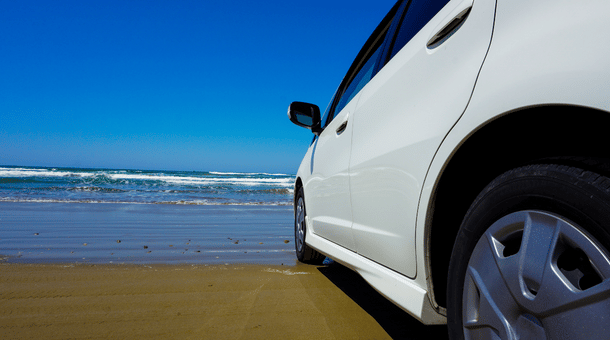Driving your car to the beach is quite an enjoyable experience for sure. However, doing so needs preparation and caution as the whole experience can go wrong by even one silly mistake. Many people like driving on beaches and commit common mistakes while doing so.
This article is related to Top 10 tips for driving your car to the Beach and I also guide on how to park and wash your car when you’re on the beach.
Top 10 Tips for Taking Your Car to the Beach
1. Do your homework
Check out local council websites and popular 4WD magazines for information on which beaches permit the use of vehicles. If vehicles are permitted, you will usually be able to find marked access routes and appropriate signage.
If in doubt, contact the local tourist information center. Use established access routes – they are a better option for your vehicle and reduce unnecessary damage to dune ecosystems.
2. Lighten your load
It might seem common sense, but removing any unwanted fittings or miscellaneous items from your vehicle can reduce its overall weight.
The lighter the vehicle, the less likely it will get bogged. Pack smart, and if you do get bogged, unload all passengers before you attempt to drive out.
3 Check your clearance
Suppose you’ve never taken your vehicle on the beach before; whip out the measuring tape and check the level of clearance between the underside of the vehicle and the ground.
Anything less than 180mm could mean the vehicle will bottom out when cresting, even a slight rise in the sand. Ultimately, this translates to a loss of momentum and an increased likelihood of getting bogged.
4. Watch the water
Tides are a governing force for all beachgoers, so ensure you’re not driving during an incoming high tide. Always pack a tide chart for the relevant area and check it before you head out.
Aim to start your journey on an outgoing high tide – the sand will be firm, and you’ll have ample time to reach your destination before the next high tide returns. Stay clear of the water’s edge – one rogue wave is all it takes to lift or roll a vehicle.
5. Lower your tire pressure
Most 4WD vehicles will have a road-driving tire pressure between 32-38psi. Lowering your tire pressure will help spread the tire out, increasing the surface area in contact with the sand.
“Start at 25psi. You shouldn’t go any lower than 18psi,”. “When you lower your tyre, it gives you a longer foot print – that’s what gives you better traction on slippery surfaces.”
There are consequences of lowering tire pressure, including a lag in steering and braking response so make sure to account for these changes while driving. Always increase the tire pressure before you drive back onto the bitumen, or you’ll risk rolling the tire completely off the wheel.
6. Maintain momentum
If you’re coming up to an area of loose, soft sand, ensure you maintain or marginally increase your speed. The slower the vehicle travels, the longer it has to sink into the sand and dig itself into a rut. Momentum is the key to maximizing fuel usage and reducing the likelihood of getting bogged.
7. Be prepared to be bogged
Accept the inevitable – at some point, you’re going to get bogged. Shovels, snatch-straps and shackles, Max Trax high visibility treads or equivalent, a tire deflator, and a compressor are all essential recovery gear.
If you get bogged, don’t spin the wheels, as this will only dig the tires in deeper. A set of four MaxTrax or equivalent will set you back around $500, but that’s money well spent.
“MaxTrax reduce resistance and assist in recovery – it’s probably one of the safest options out there,”
If you’re operating on a tight budget, use a shovel to dig a path in front of each tire and clear away sand from beneath the underbelly of the vehicle before you attempt to drive out. “Any part of the vehicle that’s touching the sand is causing resistance,”.
8. Be aware of road rules
The surface you’re driving on might have changed, but road rules still apply. Always ensure your passengers wear seatbelts, follow the speed limits, and avoid drink-driving. Police do enforce road rules, particularly in popular holiday destinations.
“A lot of the beaches that we’re permitted to use have the same rules as the road,”.
Driving on the beach is about having fun, but that doesn’t mean safety should fly out the window.
9. Be considerate
Most people who drive on the beach do so recreationally, so let’s keep the good vibes going and leave the drama by the roadside.
A little bit of courtesy will go a long way – give way to others, avoid tail-gaiting, park away from the main driving strip of the beach and be willing to offer assistance to those in need.
Most beaches that allow vehicles also generate foot traffic, so be wary of people, animals, and gear.
10. Leave nothing behind but your tire tracks
A plastic bag skimming across the sand or a hunk of dirty Styrofoam poking out among the leafy dunes are the last features we like to see dotting our natural vistas.
Take two rubbish bags with you, one for recycling and one for general rubbish. Even organic matter like lunch scrap shouldn’t be left behind – feral dogs and foxes are attracted to leftovers and predate on native species.
Driving on the beach is a fantastic way to enjoy Australia’s wild coastlines, and it’s a privilege that future generations should also be able to enjoy.
FAQ About Driving your car to the beach:
Does sand mess up your car?
Too much sand or dust can clog the air filter and reduce airflow to the engine, leading to overheating and internal damage to your vehicle. Dust buildup, in particular, can also clog your cabin air filter and diminish engine oil quality, resulting in a need for more frequent vehicle maintenance.
Should I turn the traction control off in the sand?
It’s important to keep traction control 99% of the time when driving. However, there are some cases where the safety feature could do more harm than good. For example, keeping it off is better if you get stuck in the mud, sand, or even snow.
How Driving your car to the beach?
wash your car: If you’re a frequent beach visitor or live close to the ocean, wax your car often. Waxing your car is an effective way to protect it from the salty air and sand. The wax creates a barrier that makes it more difficult for salt and sand to rust and scratch your car’s paint.




